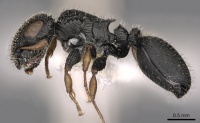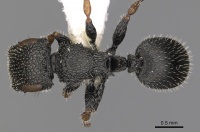Cataulacus centrurus
| Cataulacus centrurus | |
|---|---|

| |
| Scientific classification | |
| Kingdom: | Animalia |
| Phylum: | Arthropoda |
| Class: | Insecta |
| Order: | Hymenoptera |
| Family: | Formicidae |
| Subfamily: | Myrmicinae |
| Tribe: | Crematogastrini |
| Genus: | Cataulacus |
| Species: | C. centrurus |
| Binomial name | |
| Cataulacus centrurus Bolton, 1982 | |
Nothing is known about the biology of Cataulacus centrurus.
Identification
A member of the tenuis group. As indicated by the stalked-suborbicular cephalic hairs centrurus belongs to the complex of species centring on Cataulacus brevisetosus, and is most closely related to the smaller Cataulacus moloch. In the latter species the simple pilosity of the alitrunk and gaster is very short and stubble-like, whereas in centrurus it is long and conspicuous. The specialized cephalic hairs of moloch are sparser than in centrurus, have the basal stems of the hairs shorter and the apices less strongly expanded. With the head in profile the specialized hairs immediately in front of the eye have the basal stem longer than the swollen apex in centrurus, shorter than the swollen apex in moloch. In profile the propodeal spines of centrurus have the basal third elevated and the apical two-thirds recurved, a feature not seen in moloch where the spines are exceedingly feebly but evenly curved along their length. Finally, the shape of the subpetiolar process differs in the two species, that of moloch having the posteroventral angle more salient and the ventral surface more concave than in centrurus. (Bolton 1982)
Keys including this Species
Distribution
Distribution based on Regional Taxon Lists
Afrotropical Region: Cameroun (type locality).
Distribution based on AntMaps
Distribution based on AntWeb specimens
Check data from AntWeb
Countries Occupied
| Number of countries occupied by this species based on AntWiki Regional Taxon Lists. In general, fewer countries occupied indicates a narrower range, while more countries indicates a more widespread species. |

|
Estimated Abundance
| Relative abundance based on number of AntMaps records per species (this species within the purple bar). Fewer records (to the left) indicates a less abundant/encountered species while more records (to the right) indicates more abundant/encountered species. |

|
Biology
|
Castes
Nomenclature
The following information is derived from Barry Bolton's Online Catalogue of the Ants of the World.
- centrurus. Cataulacus centrurus Bolton, 1982: 359, fig. 33 (w.) CAMEROON.
- Type-material: holotype worker.
- Type-locality: Cameroon: Nkoemvon, 1979 (D.A. Jackson).
- Type-depository: BMNH.
- Status as species: Bolton, 1995b: 137.
- Distribution: Cameroon.
Unless otherwise noted the text for the remainder of this section is reported from the publication that includes the original description.
Description
Worker
HOLOTYPE WORKER. TL 3.9, HL 1.00, HW 0.92, CI 92, EL 0.47, OI 51, SL 0.48, SI 52, PW 0.70, AL 1.10.
With the head in full-face view the lateral margins of the head behind the eyes denticulate, terminating posteriorly in a short tooth at the occipital corner. Occipital crest absent, the dorsum of the head rounding evenly but narrowly into the occipital surface; the occipital margin itself unarmed except for a small tooth situated close to the tooth at the corner. Eyes relatively large, OI > 50. Alitrunk with promesonotum both longitudinally and transversely convex. In profile the highest point at about the midlength of the pronotum, the remainder sloping evenly downwards posteriorly to the base of the propodeal spines. Anterior strongly curved portion of pronotal dorsum with a number of minute peaks or tubercles from which hairs arise; such peaks absent elsewhere on alitrunk. Tooth at base of mesokatepisternum developed. Propodeal spines in profile with the basal third elevated at an angle of about 45°, the apical two-thirds back-curved. Metapleural lobes low and rounded. With the alitrunk in dorsal view the pronotal corners denticulate and the lateral margins of the pronotum armed with a series of 6-7 regularly spaced triangular denticles. Lateral margins of mesonotum with a pair of small denticles whose bases are fused, situated at approximately the midlength. Following the metanotal identation of the margin the sides of the propodeum are equipped with 2-3 small tubercles. Propodeal spines in dorsal view broad and evenly divergent. Petiole in profile rising to a sharp peak dorsally, behind which the surface slopes evenly downwards to the postpetiolar junction. Subpetiolar process with a bluntly rounded anterior lobe and a weakly developed posteroventral tooth. Postpetiole in profile with its dorsal and posterior surfaces tuberculate and its ventral process simple, short digitiform. First gastral tergite not marginate laterally, conspicuously longer than broad. Dorsum of head finely and evenly reticulate-rugulose, the recticular meshes of irregular size and the rugulae low and rounded. Ground-sculpture in the meshes reduced to an inconspicuous vestigial superficial shagreening, without punctulae. Pronotal dorsum similarly but somewhat more strongly sculptured, the reticulum breaking down on the mesonotum so that the longitudinal component predominates and the cross-meshes are reduced or incomplete. Propodeal dorsum more strongly and predominantly longitudinally rugose, irregular centrally. Transverse rugae are present between the bases of the propodeal spines. Ground-sculpture of alitrunk mostly as head but the mesonotum with some minute and virtually effaced punctulae. Petiole in dorsal view longitudinally rugose, the sculpture converging posteriorly. Postpetiole dorsum irregularly rugulose. First gastral tergite blanketed by fine dense reticulate-punctate sculpture, the basal quarter also with widely spaced fine longitudinal costulae. Behind this level the tergite with scattered short longitudinal rugulae which are very fine and irregular and formed by the alignment of the margins of adjacent punctures. First gastral sternite reticulate-punctate. Sides of pronotum obliquely sulcate, the mesopleuron transversely sulcate and the sides of the propodeum more or less vertically so behind the level of the spiracle. Sides of petiole and postpetiole longitudinally sulcate-rugose. Discounting the long simple hairs which arise round the eyes the entire dorsum of the head thickly clothed with stalked-suborbicular hairs, the stems of the hairs long and fine and holding the suborbicular distal portions well clear of the surface of the head. Occipital surface with a number of elongate narrowly clavate hairs. All remaining dorsal surfaces of body densely clothed with moderately long stout cylindrical simple hairs which are truncated apically; those on the alitrunk and petiole straight, those on the postpetiole and first gastral tergite weakly back-curved. Colour uniform black, glossy; the scapes, tibiae and tarsal segments dull yellow.
Type Material
Cameroun: Nkoemvon, 1979 (D. Jackson) (The Natural History Museum).
References
- [[Media:Bolton 1982.pdf|Bolton, B. 1982. Afrotropical species of the myrmecine ant genera Cardiocondyla, Leptothorax, Melissotarsus, Messor and Cataulacus (Formicidae). Bulletin of the British Museum (Natural History). Entomology, 46: 3*Mbenoun Masse, P.S., Ebolo, G.L.M., Titti, G.E., Mony, R. (2021) Ant species richness, abundance and functional groups along an elevation gradient in Central Cameroon Biodiversity Journal, 2021, 12 1.: 179–194. Biodiversity Journal 12, 179–194 (doi:10.31396/biodiv.jour.2021.12.1.179.194).
07-370.]]

